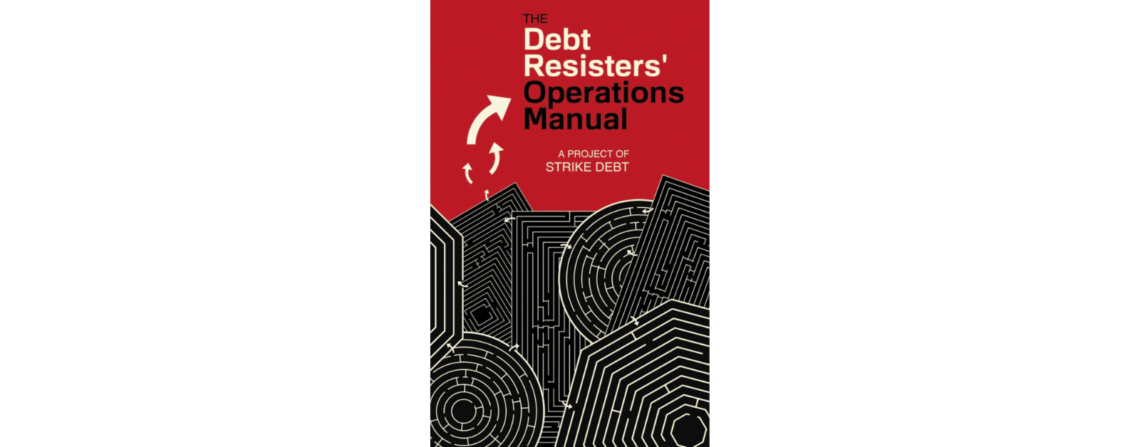The Debt Resisters’ Operations Manual by Strike Debt provides readers with both practical knowledge for dealing with various forms of debt and the larger context of debt’s function in maintaining class and racial inequality. Collectively authored, contributors include the late David Graeber and Astra Taylor.
Industrial Worker spoke with Ramsey Kanaan of PM Press about the book. The following interview was edited for length and clarity.
IW: The organization that put the manual together is called Strike Debt. Can you talk about this organization, its history, current aims, and whether it is doing other initiatives outside of this manual?
Kanaan: Initially emerging out of the Occupy movement, Strike Debt is a loose collection of individuals and organizations that have come together at various junctures to campaign—for political, economic, and social reasons—for the elimination of all debt. They’ve been concentrating on practical ways to eliminate what’s called personal household debt, and that means in particular student debt. But while debt is considered to be an individual issue or concern, they deliberately posit that it’s a social and political concern, meaning that individual debt is actually an economic and social concern for all of us. Hence eliminating it is a political act.
There are Strike Debt collectives all over the Americas, so I encourage folks to seek out their local brothers and sisters to get involved in that struggle.
IW: What sort of resources does the manual provide to people struggling with debt?
Kanaan: The book provides two kinds of resources. It provides immediately practical resources, like how you can start dealing with your own personal debt. On a larger level, the book provides social context because debt resistance—particularly if it is going to be successful for more than just the occasional individual—has to be a social act. So, the book also provides certain tools for organizing collective class resistance to debt rather than an atomized, individual response.
IW: Strike Debt is part of a larger popular response to neoliberalism. In what ways does the current system of debt and credit in the US fit in or relate to this form of capitalism?
Kanaan: As you know capitalism, and today’s amped-up neoliberal project, in particular, is based on the extraction of this so-called surplus wealth from anyone and everyone. Debt serves as a way of increasing and leveraging that wealth since of course, it’s not just about paying a debt but paying interest on that debt. So that debt accumulates further and becomes increasingly more costly for the debtor.
In the old days, if you were in debt and couldn’t pay, they would throw you in a debtors’ prison. This was the most common form of imprisonment 200 years ago in the UK. You would just go to prison; you weren’t expected to carry on paying that debt with compounded interest. With neoliberalism, there has been an accentuation or acceleration of that debt process.
Neoliberalism has been very successful in counteracting the falling rate of profits, which is why neoliberalism arose in the early 70s. It was capital’s response to that stagnation. The neoliberal solution included further integrating average people into the money system. So, we give everyone credit cards, we give them access to more expensive forms of banking to buy their own homes. It draws your average person further and further into that matrix of debt from which greater wealth can be extracted.
And of course, it has to be remembered that in the neoliberal age, public-private partnership means how can private entities better bilk the public. A classic example of this is the state bailing out the banks with taxpayers’ money—i.e. public wealth—during the Great Recession of 2008. However, that same public institution—the state—refuses to cancel student debt. Those same banks that were considered “too big to fail” own (collect) the majority of this debt. That’s the way the game is rigged.
With the threat of the continuation of student loan repayments looming over many, the Debt Collective—a debtors’ union whose members are counted among the contributors to the Debt Resistor’s Manual—are preparing for a national debt strike. They are coordinating all people in the US with student debt who are willing and able to avoid or refuse monthly payments should the US government end the COVID-19 era relief moratorium which has paused mandatory payments during the pandemic. The hope is that by standing together, the countless people in the US burdened with insurmountable student debt can turn their economic precarity into a force capable of pushing for real change from the bottom up. See the July 26 Student Debt Strike info session on YouTube for more information!
The Debt Resisters’ Operations Manual by Strike Debt is available for sale in the IWW Store.

